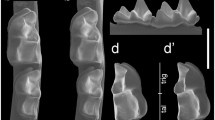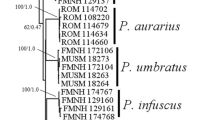Abstract
We present a phylogeny of 35 species of nectar-feeding bats based on 119 morphological characters: 62 from the skin, skull, and dentition and 57 soft tissue characters (the latter from Wetterer et al., 2000). These data support monophyly of the subfamilies Brachyphyllinae, Phyllonycterinae, and Glossophaginae, and the tribes Glossophagini and Lonchophyllini. Our analysis contradicts the phylogeny estimated from the RAG-2 gene, which does not support a monophyletic Glossophaginae (Baker et al., 2000). Parsimony analysis of a combined matrix, containing morphological characters and RAG-2 sequences, results in a phylogeny that includes Brachyphyllinae and Phyllonycterinae in Glossophaginae. Support for most clades is stronger than in the morphological tree, but support for basal nodes of the phylogeny remains weak. The weak support at these basal nodes underscores the historical disagreements regarding relationships among these taxa; combining morphological and molecular data has not improved support for these nodes. Uncertainty regarding basal relationships complicates description of morphological change during the evolution of nectarivory in the Phyllostomidae.
Similar content being viewed by others
LITERATURE CITED
Alvarez, J., Willig, M. R., Knox Jones Jr., J., and Webster, W. D. (1991). Glossophaga soricina. Mammal. Species 379: 1–4.
Baker, R. J. (1967). Karyotypes of bats of the family Phyllostomidae and their taxonomic implications. Southwest. Nat. 12: 407–428.
Baker, R. J., and Bass, R. A. (1979). Evolutionary relationships of the Brachyphyllinae to the glossophagine genera Glossophaga and Monophyllus. J. Mammal. 60: 364–372.
Baker, R. J., Honeycutt, R. L., Arnold, M. L., Sarich, V. M., and Genoways, H. H. (1981). Electrophoretic and immunological studies of the relationship of the Brachyphyllinae and the Glossophaginae. J. Mammal. 62: 665–672.
Baker, R. J., Porter, C. A., Patton, J. C., and Van Den Bussche, R. A. (2000). Systematics of the family Phyllostomidae based on RAG-2 DNA sequences. Occ. Pap. Mus. Tex. Tech Univ. 202: 1–16.
Bremer, K. (1988). The limits of amino acid sequence data in angiosperm phylogenetic reconstructions. Evol. 42: 795–803.
Brooks, D. R., and McLennan, D. A. (1991). Phylogeny, Ecology, and Behavior: A Research Program in Comparative Biology. University of Chicago Press, Chicago.
Buzato, S., and Franco, A. L. M. (1992). Tetrastylis ovalis: A second case of bat pollinated passionflower (Passifloraceae). Pl. Syst. Evol. 181: 261–267.
Corbet, G. B., and Hill, J. E. (1980). A World List of Mammalian Species, 1st Edition. London: British Museum.
de la Torre, L. (1961). The evolution, variation, and systematics of the neotropical bats of the genus Sturnira. Ph.D. Diss., Univ. Illinois, Urbana.
Eguiarte, L., and Burquez, A. (1987). Reproductive ecology of Manfreda brachystachya, an iteroparous species of Agavaceae. Southwest. Nat. 32: 169–178.
Felsenstein, J. (1982). Numerical methods for inferring evolutionary trees. Q. Rev. Biol. 57: 379–404.
Felsenstein, J. (1985). Confidence limits on phylogenies: An approach using the bootstrap. Evol. 39: 783–791.
Fisher, E. A. (1992). Foraging of nectarivorous bats on Bauhinia ungulata. Biotrop. 24: 579–582.
Freeman, P. (1995). Nectarivorous feeding mechanisms in bats. Biol. J. Linn. Soc. 56: 439–463.
Gardner, A. L. (1977). Chromosomal variation in Vampyressa and a review of chromosomal evolution in the Phyllostomidae (Chiroptera). Syst. Zool. 26: 300–318.
Gibbs, P. E., Oliveira, P. E., and Bianchi, M. B. (1999). Postzygotic control of selfing in Hymenaea stigonocarpa (Leguminosae caesalpinioideae), a bat-pollinated tree of the Brazilian cerrados. Int. J. Plant Sci. 160: 72–78.
Gimenez, E. D. A., Ferrarezzi, H., and Taddei, V. A. (1996). Lingual morphology and cladistic analysis of the New World nectar-feeding bats (Chiroptera: Phyllostomidae). J. Comp. Biol. 1: 41–64.
Gribel, R., and Hay, J. D. (1993). Pollination ecology of Caryocar brasiliense (Caryocaraceae) in Central Brazil cerrado vegetation. J. Trop. Ecol. 9: 199–211.
Gribel, R., Gibbs, P. E., and De Queiroz, A. L. (1999). Flowering phenology and pollination biology of Ceiba pentandra (Bombaceae) in Central Amazonia. J. Trop. Ecol. 15: 247–253.
Griffiths, T. A. (1982). Systematics of the new world nectar-feeding bats (Mammalia: Phyllostomidae) based on the morphology of the hyoid and lingual regions. Amer. Mus. Novit. 2742: 1–45.
Griffiths, T. A. (1983). On the phylogeny of the Glossophaginae and the proper use of outgroup analysis. Syst. Zool. 32: 283–285.
Heithaus, E. R., Opler P. A., and Baker, H. G. (1974). Bat activity and pollination of Bauhinia pauletia: Plantpollinator coevolution. Ecol. 55: 412–419.
Heithaus, E. R., Stashko, E., and Anderson, P. K. (1982). Cumulative effects of plant-animal interactions on seed production by Bauhinia ungulata, a Neotropical legume. Ecol. 63: 1294–1302.
Herrera, L. G. M., and Del Rio, C. M. (1998). Pollen digestion by New World Bats: Effects of processing time and feeding habits. Ecol. 79: 2828–2838.
Honeycutt, R. L., and Sarich, V. M. (1987). Albumin evolution and subfamilial relationships among New World leaf-nosed bats (family Phyllostomidae). J. Mammal. 68: 508–517.
Hopkins, H. C. (1984). Floral biology and pollination ecology of the Neotropical species of Parkia. Ecol. 72: 1–23.
Huelsenbeck, J. P., Hillis, D. M., and Jones, R. (1996). Parametric bootstrapping in molecular phylogenetics: Applications and performance. In: Molecular Zoology: Advances, Strategies, and Protocols, J. D. Ferraris and S. R. Palumbi, eds., pp. 519–545, Wiley-Liss, New York, NY.
Jones, J. K., Jr., and Homan, J. A. (1974). Hylonycteris underwoodi. Mammal. Species 32: 1–2.
Koopman, K. (1993). Order Chiroptera. In: Mammal Species of the World, D. E. Wilson and D. M. Reeder, eds., pp. 137–241, Smithsonian Institution Press, Washington, D.C.
Koopman, K. F., and Jones, JR., J. K. (1970). Classification of bats. In: About Bats, B. H. Slaughter and W. D. Walton, eds., pp. 22–28, South. Meth. Univ. Press, Dallas, TX.
Lim, B. K. (1993). Cladistic reappraisal of neotropical stenodermatine bat phylogeny. Cladistics 9: 147–165.
Luckow, M., and Hopkins, H. C. F. (1995). A cladistic analysis of Parkia (Leguminosae: Mimosoideae). Amer. J. Bot. 82: 1300–1320.
Machado, I. C. S., Sazima, I., and Sazima, M. (1998). Bat pollination of the terrestrial herb Irlbachia alata (Gentianaceae) in northeastern Brazil. Pl. Syst. Evol. 209: 231–237.
Maddison, W. P., and Maddison, D. R. (1992). MacClade: Analysis of Phylogeny and Character Evolution, Version 3.04. Computer program distributed by Sinauer, Sunderland, MA.
McKenna, M. C., and Bell, S. K. (1997). Classification of Mammals above the Species Level. Columbia University Press, New York, NY.
Nellis, D. W., and Ehle, C. P. (1977). Observations on the behavior of Brachyphylla cavernarum (Chiroptera) in Virgin Islands. Mammalia 41: 403–409.
Novak, R.M. (1994). Walker's Mammals of the World, Fifth Edition, Vol. 2. The Johns Hopkins Univ. Press, Baltimore, MD.
Phillips, C. J. (1971). Dentition of glossophagine bats. Univ. Kansas Publ., Mus. of Nat. Hist. 54: 1–138.
Rambaut, A., and Grassly, N. C. (1997). Seq-Gen: An application for the Monte Carlo simulation of DNA sequence evolution along phylogenetic trees. Comp. Applic. Biosci. 13: 235–238.
Ramirez, N., Sobrevila, C., De Enrech, N. X., and Ruiz-Zapata, T. (1984). Floral biology and breeding system of Bauhinia benthamiana taub. (Leguminosae), a bat-pollinated tree in the Venezuelan “Llanos”. Amer J. Bot. 71: 273–280.
Silva-Taboda, G. S., and Pine, R. H. (1969). Morphological and behavioral evidence for the relationship between the bat genus Brachyphylla and the Phyllonycterinae. Biotrop. 1: 10–19.
Simmons, N. B. (1998). A reappraisal of interfamilial relationships of bats. In: Bats: Biology and Conservation, T. H. Kunz and P. A. Racey eds., pp. 3–26, Smithsonian Press, Washington, D. C.
Simmons, N. B., and Geisler, J. H. (1998). Phylogenetic relationships of Icaronycteris, Archaeonycteris, Hassianycteris, and Palaeochiropteryx to extant bat lineages, with comments on the evolution of echolocation and foraging strategies in Microchiroptera. Bull. Amer. Mus. Nat. Hist. 235: 1–182.
Simpson, G. G. (1945). The principles of classification and a classification of the mammals. Bull. Amer. Mus. Nat. Hist. 85: 1–350.
Smith, J. D. (1976). Chiropteran evolution. In: Biology of the Bats of the New World Phyllostomidae, Part I., R. J. Baker, J. K. Jones, Jr., and D. C. Carter, eds. Spec. Publ. Mus. Texas Tech Univ. 10: 49–69.
Sorenson, M. D. (1999). TreeRot, version 2. Boston University, Boston MA.
Straney, D. O. (1980). Relationships of Phyllostomatine Bats: Evaluation of Phylogenetic Hypotheses. Ph.D. Diss., Univ. of California, Berkeley.
Sullivan, J. (1996). Combining data with different distributions of among-site rate variation. Syst. Biol. 45: 375–380.
Sullivan, J., Markert, J. A., and Kilpatrick, C. W. (1997). Phylogeography and molecular sytematics of the Peromyscus aztecus species group (Rodentia: Muridae) inferred using parsimony and likelihood. Syst. Biol. 46: 426–440.
Sullivan, J., Arellano, E., and Rogers, D. S. (2000). Comparative phylogeography of Mesoamerican highland rodents: Concerted versus independent responses to past climatic fluctuations. Amer. Nat. 155: 755–768.
Swofford, D. L. (2002). PAUP*. Phylogenetic Analysis Using Parsimony (*and other methods). (PAUP*) Version 4.0b4a. Sinnauer and Associates, Sunderland, MA.
Valiente-Banuet, A. A., Rojas-Martinez, M., Casas, M., Del Coro-Arizmendi, M., and DaVila, P. (1997). Pollination biology of two winter-blooming giant columnar cacti in the Tehuacan Valley, central Mexico. J. Arid Envir. 37: 331–341.
Voss, R., Turner, M., Inouye, R., Fisher, M., and Cort, R.. (1980). Floral biology of Markea neurantha Hemsley (Solanaceae), a bat-pollinated ephiphyte. Amer. Mid. Nat. 103: 262–268.
Wetterer, A. L., Rockman, M. V., and Simmons, N. B. (2000). Phylogeny of phyllostomid bats (Mammalia: Chiroptera): Data from diverse morphological systems, sex chromosomes, and restriction sites. Bull. Amer. Mus. Nat. Hist. 248: 1–200.
Wilkinson, M. (1995). A comparison of two methods of character construction. Cladistics 11: 297–308.
Winkelman, J. R. (1971). Adaptations for Nectar-Feeding in Glossophagine Bats. Ph. D. Diss., Univ. of Michigan, Ann Arbor.
Winter, Y. (1998). Energetic cost of hovering flight in a nectar-feeding bat measured with fast-response respirometry. J. Comp. Physiol. B. 168: 434–444.
Winter, Y., Voight, C., and Von Helverson, O. (1998). Gas exchange during hovering flight in a nectar-feeding bat Glossophaga soricina. J. Exper. Biol. 201: 237–244.
Yang, Z., Goldman, N., and Friday, A. (1995). Maximum likelihood trees from DNA sequences: A peculiar statistical estimation problem. Syst. Biol. 44: 384–399.
Author information
Authors and Affiliations
Corresponding author
Rights and permissions
About this article
Cite this article
Carstens, B.C., Lundrigan, B.L. & Myers, P. A Phylogeny of the Neotropical Nectar-Feeding Bats (Chiroptera: Phyllostomidae) Based on Morphological and Molecular Data. Journal of Mammalian Evolution 9, 23–53 (2002). https://doi.org/10.1023/A:1021331711108
Issue Date:
DOI: https://doi.org/10.1023/A:1021331711108




